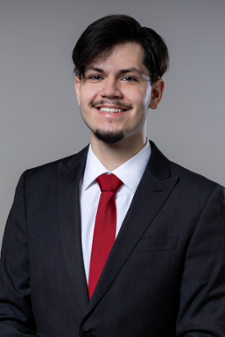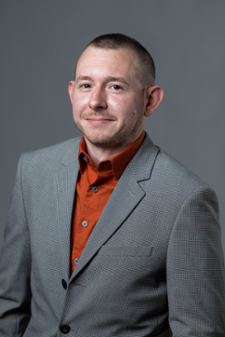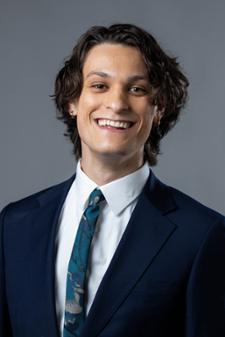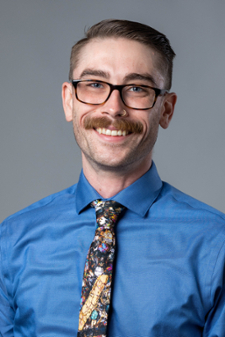 Victor Arellano
Victor ArellanoHometown: Stockton, Missouri
Major: Public Health
Faculty Mentor: Joseph Lightner
Mentor's Department: Nursing and Health Studies
Funding Source: UMKC SUROP Grant
Falls in Older Adults: Preventing Risks with Physical Activity and Cycling
In the United States, adults aged 65 or older (older adults) are at an increased risk of injury from a fall. Reducing an individual’s risk of falling is crucial to avoiding an injury or fatality. Older adults with higher physical activity (PA) through behaviors such as cycling are less likely to fall. This study aimed to compare the PA and balance of older adults who regularly cycled to older adults with little to no reported PA and the number of self-reported falls. Older adults (n=46) were largely recruited from online groups and flyers placed at local community centers. Participants were divided into cyclists (n=19) and noncyclists (n=27) based on regular cycling activity. Each participant completed a one-time visit to fill out a series of surveys, including the Activities-Specific Balance Confidence (ABC) scale, and performed a balance assessment. Each individual also received a Garmin Vivofit 4 accelerometer to track PA. Survey answers and PA data were analyzed using IBM SPSS 27.
On average, cyclists recorded more weighted active minutes (89.98 minutes) than noncyclists (47.61 minutes). An analysis of the recorded data of noncyclists showed a significance (p=0.003) between weighted active minutes and the number of self-reported falls, while cyclists did not show significance. Additionally, scores from the ABC also yielded a statistical significance for balance. Decreasing the risk of a fall is crucial to avoiding injury in older adults. Cyclists show to have increased PA and fewer reported falls on average. Increased balance and physical activity have potential benefits for adults at risk of falling during daily life.
 Maya Baughn
Maya BaughnHometown: Independence, Missouri
Major: Health Sciences
Faculty Mentor: Amanda Grimes
Mentor's Department: Nursing and Health Studies
Funding Source: UMKC Retirees Association Scholarship in Aging Research
Impact of COVID-19 Pandemic on Middle Aged and Older Adults' Physical Activity Levels
Physical activity is important for middle aged and older adults to maintain physical and mental health and is a protective factor for viral infections. As a result of its importance, it is vital to understand barriers to physical activity and if trends of low physical activity have continued throughout the pandemic. Therefore, the purpose of this study is to qualitatively explore the impact of the COVID-19 pandemic on middle aged and older adults’ physical activity nearly 6 months into the pandemic. Undergraduate students conducted interviews with adults aged 50+, asking how their activity was impacted due to the COVID-19 pandemic. Approximately 230 interviews were conducted with a diverse sample of participants from the Midwest (22.5% Black and 11.0% Hispanic).
Overall, most older adults interviewed (54.6%) reported no change in their physical activity, often reporting that their work kept them active. Additionally, a total of 42.7% of the sample reported decreases with 27.8% of reported decreases being from Black and 10.3% from Hispanic respondents. Limited access to social relationships with friends and family and strictly following stay-at-home restrictions were cited as reasons for decreased physical activity levels. The few reporting an increase (2.6%) in physical activity had more time available to be active, including setting goals while staying home. This data provides an insight on how COVID-19 impacted activity levels for older adults. These findings can inform tailored interventions to promote physical activity during the pandemic. For example, interventions should focus on safely leveraging social relationships to increase activity levels.
 Kyle Broley
Kyle BroleyHometown: Kansas City, Missouri
Major: Earth and Environmental Sciences
Faculty Mentor: Alison Graettinger
Mentor's Department: Earth and Environmental Sciences
Funding Source: UMKC SUROP Grant; UMKC SEARCH Grant
Xenolith Structures in Welded Basalt Agglutinate Associated with Dotsero Crater, Colorado
The focus of this study is to gain a detailed understanding of the lava and sediment interactions that occurred at the Dotsero maar volcano in Dotsero, Colorado through examination and analysis of xenoliths within the welded agglutinate. A xenolith, or foreign rock, can be described as a fractured piece of underlying sediment that has been transported to the surface by magma during an eruption and can be found within volcanic deposits like welded agglutinate, or cooled lava spatter. The Dotsero maar volcanic crater formed through phreatomagmatic, processes involving lava interacting with groundwater, and magmatic processes around 4,150 ± 300 years B.P. and erupted through sections of Pennsylvanian sediment deposits (323 - 299 Ma). Field observations of the eruptive material showed a variety of xenolith structures which were classified into four specific categories based on grain size and variations in the color of the sediments.
Detailed laboratory analyses included X-Ray powder diffraction and scanning electron microscopy of local surface sediments and xenolith samples collected from the three sites south of Dotsero Crater. These analyses will provide answers to thermal impacts and deformation on the localized sediment xenoliths from the eruption event to gain a deeper understanding of the impacts to the surface sediments and provide the groundwork for future analysis and study. The skills used to describe and reconstruct regional geology are valuable to addressing a wide range of problems, both here in Missouri and beyond.
 Nina Cherry
Nina CherryHometown: Prairie Home, Missouri
Major: Music Theory
Faculty Mentor: Alison DeSimone
Mentor's Department: Musicology
Funding Source: UMKC SUROP Grant
Reframing the Narrative: Uncovering Kansas City Women in Jazz
The jazz canon, formed primarily by white, male scholars of the twentieth century, has neglected and trivialized the careers of women within the genre, especially instrumentalists. This research project investigates the historically underrepresented and forgotten women in Kansas City jazz. These women were highly influential to the development of the region’s distinct style, which, in turn, greatly contributed to the city’s growth, although history texts do not reflect this. Even in the twenty-first century, the contributions of women in jazz remain overshadowed and diluted by their male colleagues and competitors. This research diversifies the highly gendered jazz canon, as well as reframes Kansas City jazz history, and the city’s history at large, which excludes Black women disproportionately. This research has been used to create a database of Kansas City women in jazz: Countess. Countess preserves the legacies of the women that helped build the vibrant Kansas City jazz scene and spotlights the women on today’s scene that keep the Kansas City jazz tradition alive and thriving through a free, online, and widely accessible medium.
 Victoria Dominguez
Victoria DominguezHometown: Independence, Missouri
Major: Spanish; Sociology
Faculty Mentor: Viviana Grieco
Mentor's Department: History; Latin American and Latinx Studies
Funding Source: UMKC Emerging Research Scholars Program
Student Life through the Art of Luis Quintanilla: A Study of the Murals in Haag Hall
In 1941, Clarence Decker, President of the University of Kansas City (UKC, today UMKC) between 1938 -1953, offered Luis Quintanilla (1893-1978), a Spanish artist who mastered the Italian fresco painting technique, a position as a resident professor. Quintanilla lived through the World Wars and the Spanish Civil War (1936-1939). He opposed the dictatorship of Francisco Franco and lived in exile in New York City until the 1950s. Then, he relocated to France and returned to Spain in 1976 (after Franco’s death) where he resided until his own death in 1978. Counting on the support of the Emergency Committee in Aid of Displaced Foreign Scholars (which was established to aid scientists and academics fleeing from Nazi Germany), Dr. Decker invited Quintanilla to UKC to establish the first fresco painting school in the United States. While painting murals on the walls of the Liberal Arts Hall (present-day Haag Hall), Quintanilla was given the opportunity to train apprentices and engage with the students who served as models. My research focuses on Dr. Decker’s efforts at broadening the academic scope of the university by appointing prominent international figures to the faculty. Additionally, it explores how the university engaged with students beyond the classroom. Finally, it studies the institutional and financial support UKC received from the Emergency Committee and other organizations that aided American universities interested in hiring displaced scholars. For advancing this project, I read and analyzed original primary sources housed at UMKC’s archives, UMKC’s LaBudde Special Collections, The Rockefeller Foundation, and the New York City Public Library. I consulted Dr. Decker’s correspondence, UKC’s yearbooks, the records of the Committee in Aid of Displaced Foreign Scholars, and Rockefeller Foundation’s Annual Reports, Articles from the Kansas City Star covering the progress of the murals as well as New York Times articles concerning foreign scholars were accessed online. My research is relevant to Missourians as it shows how higher-education institutions promote cultural engagement through students’ activities within and outside the classroom. While they were painted, Quintanilla’s murals were noted by the press and the local community. However, over time, they received less attention. I hope that my work helps these murals become noted beyond the walls of Haag Hall.
 Jordy Hernandez
Jordy HernandezHometown: Shawnee, Kansas
Major: Biology; Chemistry
Faculty Mentor: Saul Honigberg
Mentor's Department: Biology
Funding Source: UMKC SEARCH Grant
The Importance of Yeast in Cancer Research
Cancer is the second leading cause of death in Missouri. Cancer is formed by mutations which prevent cells from behaving normally, for example normal regulation of cell division is lost in cancer cells. Cell division is regulated in part by a family of proteins called cyclins, and cyclin levels are raised to abnormally high levels in cancer cells causing unregulated cell division. A eukaryotic model organism, the yeast Saccharomyces cerevisiae, has been used to examine how cyclins regulate cell division. Yeast is a useful model for cancer cells because it has a short generation time, shares many biological properties with human cells, and is relatively simple to genetically manipulate. My research focuses on three yeast cyclins – Cln1, Cln2, Cln3. We are determining whether mutants in these cyclins affect surrounding cells as well as the cell containing the mutation. These experiments will define whether cyclins are involved in cell-cell communication. Understanding cyclin function in yeast could help elucidate the role of these cyclins in cancer.
 Michael Kuehn
Michael KuehnHometown: Lee's Summit, Missouri
Major: Biology; Chemistry
Faculty Mentor: Hillary McGraw
Mentor's Department: Biology
Funding Source: UMKC SEARCH Grant
Hair Cell Regeneration in Zebrafish
Approximately 18% of adults in the USA and 19% of adults in Missouri report hearing loss. Understanding the biology of hearing and hearing loss is critical to finding potential clinical treatments. In the ear, specialized cells, called hair cells, sense sound. When hair cells are damaged, they fail to regrow, resulting in hearing loss. Aquatic animals have hair cells that sense water current, and in contrast to hair cells in the ear, they can regrow following damage. Currently, I am performing undergraduate research in the McGraw lab at UMKC investigating the genetic regulation of hair development and regeneration using zebrafish (Danio rerio) as a model organism. In my research, I am using a mutant zebrafish line in a gene called Kremen1 that shows increased development and regeneration of sensory hair cells. I am using this mutant line to understand how and why excess hair cells form in the fish sensory system. Understanding the mechanisms that allow regeneration in zebrafish hair cells could help human treatment research for hearing or balance function loss.
 Hannah Leyva
Hannah LeyvaHometown: Kansas City, Kansas
Major: Sociology
Faculty Mentor: Stephen Christ
Mentor's Department: Sociology
Funding Source: UMKC Emerging Research Scholars Program
Understanding Latinx Students at an Urban Research University
The purpose of my study is to better understand the Latinx students on UMKC’s campus. UMKC plays a crucial role in its community as an urban research university. For many students, an added plus of UMKC is the small faculty-to-student ratio. This is attractive to prospective students as it often indicates more interactions with faculty to support academic success. The first mission of this study is to understand the Latinx students and how they see themselves within the larger context of UMKC’s campus. Latinx students are largely underrepresented in higher education and it is important to understand the complexities this student demographic faces in their undergraduate journeys. A better comprehension of Latinx students can be seen as an asset for campuses across the United States to improve their diversity and inclusion plans. Another aspect of this study is to survey the educators on campus and how able they feel they are to understand their Latinx students. It has been seen that if a student makes just one friend in their first year of college, they are more likely to stay. The support students receive also has a correlation to the retention rates of Latinx students on their campus. By collecting responses from both Latinx students on campus as well as their faculty, we can get two perspectives on the issue of the underrepresentation of Latinx students in higher education.
 Trenton McEnaney
Trenton McEnaneyHometown: Kansas City, Missouri
Major: Earth and Environmental Sciences
Faculty Mentor: Tina Niemi
Mentor's Department: Earth and Environmental Sciences
Funding Source: UMKC SUROP Grant; UMKC SEARCH Grant
Building a Georeferenced Database for the 1976 Guatemalan Earthquake Rupture of the Motagua Fault System along the North American-Caribbean Plate Boundary
In this study, we sought to relocate sites along the 1976 Motagua fault rupture by analyzing archival material from George Plafker of the U.S. Geological Survey who was part of the team that collected data on the effects of the earthquake within days of the event. The data included 1250 original 35 mm slides, numerous annotated 1:50:000 scale topographic maps, several hundred aerial photographs, a 1978 field trip guidebook, and various other original documents that are only available in paper format.
The process of georeferencing the data proved difficult, as names and locations of many towns, roads, and geographic features have changed or no longer exist. The data were georeferenced using Google Earth and ArcMap, and when possible, correlated to field notes and map annotations. After the files were georeferenced, a geodatabase was built in ArcMap thus providing easily accessible geospatial data for photographs. The 1976 Guatemala earthquake georeferenced database can then be loaded into a mobile GIS software such as Touch GIS for use in the field. Prior to this project, locating any of these past field sites and points of interest along the 1976 Guatemalan earthquake rupture was hindered by the lack of GPS coordinates. The new database will benefit future paleoseismic and seismic hazard analyses research.
 Grace Nanney
Grace NanneyHometown: Leawood, Kansas
Major: Psychology
Faculty Mentor: Oh-Ryeong Ha
Mentor's Department: Psychology
Funding Source: UMKC SEARCH Grant
How Stress Level and Coping Styles Impact Eating Decisions
It is widely accepted that stress and emotions lead to changes in eating behavior (Greeno and Wing, 1994; Ganely, 1989). Maladaptively coping with stress and emotions has been postulated to negatively impact eating behavior (Martyn-Nemeth et. al., 2008); therefore, identifying adaptive coping strategies that would lead to positive eating behavior changes is an integral path for public health research. Past research has identified two primary coping styles an individual uses to deal with stress: Problem-Focused Coping, where one take actions to eliminate stress; and Emotion-Focused Coping, where one tries to regulate emotions to minimize impacts of stress. My research analyzed the relationship between problem and emotion-focused coping styles and eating behavior. Participants rated foods based on taste, health, preference, and consumption using a computer food rating and choice task and completed a self-report measure concerning factors associated with eating behavior. Participants then completed a self-report measure that ascertained their preferred coping style. Results showed that individuals who engage in unhealthier eating behaviors are less likely to use problem-focused coping strategies. However, emotion-focused coping was not found to be correlated with unhealthy eating decisions. These results appear to indicate that individuals who make unhealthier eating decisions do not utilize problem-focused coping strategies when it comes to dealing with stress. Future research should seek to determine if teaching problem-focused coping strategies would lead to healthier eating decisions.